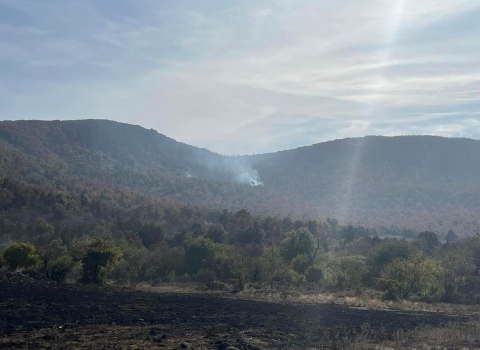Partners in Mexican wolf conservation are pleased to announce the successful fostering of 16 genetically valuable Mexican wolf pups this spring. The pups traveled from four captive facilities across the country and were placed into six wild dens in eastern Arizona and western New Mexico. This is the eighth year of fostering into the wild population of Mexican wolves, bringing the total number of fostered captive-born pups to 99.
Fostering is a proven method used by the Mexican Wolf Interagency Field Team (IFT) to increase genetic diversity in the wild Mexican wolf population. It begins with selective breeding by the Saving Animals From Extinction (SAFE) program to produce genetically diverse pups within the captive population. Within 14 days of whelping (being born), the captive-born pups are transported to the wild and mixed with similarly aged wild pups in the dens of wild Mexican wolf packs, which have been identified and selected by the IFT to provide the greatest chance of survival of the captive-born pups in the wild.
“Fostering is like a relay race for conservation,” said Agapito Lopez, a wolf technician with the U.S. Fish and Wildlife Service. “These pups start at SAFE zoos and wolf centers, are handed off to be flown on donated private flights arranged by LightHawk, then given health checks and tube fed by our trained veterinarians, and finally are hiked into their new wild dens by our field staff. It’s a carefully orchestrated process involving dozens of dedicated individuals.”
Once all the pups are placed back into the wild den, the breeding female will spend the next several weeks caring for both the wild and captive-born pups. With the help of her pack mates, the pups will be raised with the skills and knowledge needed for a life in the wild. The IFT has not detected any difference in survival rates of fostered captive-born pups and wild-born pups in their first year of life (about 50%).
“To date, we have documented 13 litters produced by fostered wolves and know of at least five offspring of fosters that have become breeding individuals in their own packs,” said Stewart Liley, Chief of Wildlife, New Mexico Department of Game and Fish. “We have documented 14 fosters reaching breeding age, a key recovery metric. It is likely that additional fostered pups are currently alive and contributing to recovery in the wild population.”
The following fostering events took place over an eight-day period in early May:
- The Brookfield Zoo in Chicago, Illinois: one litter provided six pups. Three were fostered into a pack in Arizona and three were fostered into a pack in New Mexico.
- The Endangered Wolf Center in Eureka, Missouri: one litter provided two pups that were fostered into a New Mexico pack.
- The Wolf Conservation Center in South Salem, New York: one litter provided five pups. Three were fostered into one New Mexico pack and two were fostered into a separate New Mexico pack.
- The Living Desert Zoo in Carlsbad, New Mexico: one litter provided three pups that were fostered into a New Mexico pack.
"Documenting the successes of pup fostering is a challenge that recovery partners are working to address, as recapturing fosters as grown pups or adults requires considerable resources and a bit of luck,” said Clay Crowder, Assistant Director of Wildlife Management at the Arizona Game and Fish Department. “Pups are too young to be radio collared when fostered, but genetic samples are taken so they can be identified if captured later. The IFT is continuing to evaluate applications of existing and emerging wildlife tracking and monitoring technology to develop new ways of documenting survival of fostered pups.”
One measure the IFT has initiated in 2023 is to increase genetic monitoring through DNA analysis of scat samples collected throughout the year to document fostered wolves that have not yet been captured and collared.
The IFT will continue to monitor the packs that pups were placed in through GPS and radio telemetry signals from collars on adult and sub-adult wolves within the pack. Supplemental food caches are provided for the first six months for packs that pups were fostered into, to assist with survival of the genetically valuable pups. Later, through remote camera observations, DNA analysis of scat samples and efforts to capture the young of the year, the IFT will work to document survival of pups fostered this year as well as those fostered in 2022 and previous years.
Fostering is a coordinated effort of the U.S. Fish and Wildlife Service, Arizona Game and Fish Department, New Mexico Department of Game and Fish, Bureau of Land Management, U.S. Forest Service, and the Saving Animals From Extinction program. Aerial support for this year’s operations was provided by LightHawk Conservation Flying and the Arizona Game and Fish Department’s Aviation Program.
This year is the 25th anniversary of Mexican wolf reintroduction to the wild. At the end of 2022, there were a minimum of 241 Mexican wolves in Arizona and New Mexico.
This announcement comes as the ESA turns 50 years old in 2023. Throughout the year, the Department of the Interior is celebrating the ESA’s importance in preventing imperiled species extinction, promoting the recovery of wildlife and conserving the habitats upon which they depend.


